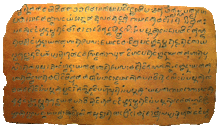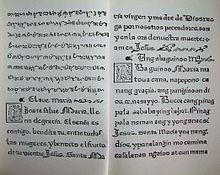Baybayin
Artists, educators, and enthusiasts use these platforms to share tutorials, artworks, and historical facts about the script, sparking interest among younger generations.The earliest known use of the word to refer to the script was from the Vocabulario de la lengua tagala (1613) by Pedro San Buenaventura as baibayin.Historically Southeast Asia was under the influence of Ancient India, where numerous Indianized principalities and empires flourished for several centuries in Thailand, Indonesia, Malaysia, Singapore, Philippines, Cambodia and Vietnam.[20] French archaeologist George Coedes defined it as the expansion of an organized culture that was framed upon Indian originations of royalty, Hinduism and Buddhism and the Sanskrit language.[22] Examples of these include raja, rani, maharlika, and datu, which were transmitted from Indian culture to Philippines via Malays and the Srivijaya empire.[citation needed] Indian Hindu colonists played a key role as professionals, traders, priests and warriors.It was written in the Kawi script in a variety of Old Malay containing numerous loanwords from Sanskrit and a few non-Malay vocabulary elements whose origin is ambiguous between Old Javanese and Old Tagalog.Geoff Wade has argued that the baybayin characters "ga", "nga", "pa", "ma", "ya" and "sa" display characteristics that can be best explained by linking them to the Cham script, rather than other Indic abugidas.[1][36] Although one of Ferdinand Magellan's shipmates, Antonio Pigafetta, wrote that the people of the Visayas were not literate in 1521, the baybayin had already arrived there by 1567 when Miguel López de Legazpi reported from Cebu that, "They [the Visayans] have their letters and characters like those of the Malays, from whom they learned them; they write them on bamboo bark and palm leaves with a pointed tool, but never is any ancient writing found among them nor word of their origin and arrival in these islands, their customs and rites being preserved by traditions handed down from father to son without any other record."[38] The earliest printed book in a Philippine language, featuring both Tagalog in baybayin and transliterated into the Latin script, is the 1593 Doctrina Christiana en Lengua Española y Tagala.There is also a series of legal documents containing baybayin, preserved in Spanish and Philippine archives that span more than a century: the three oldest, all in the Archivo General de Indias in Seville, are from 1591 and 1599.[39][5] Baybayin was noted by the Spanish priest Pedro Chirino in 1604 and Antonio de Morga in 1609 to be known by most Filipinos, and was generally used for personal writings and poetry, among others.Pedro Chirino, a Spanish priest and Antonio de Morga noted in 1604 and 1609 that most Filipino men and women could read baybayin.[40] During the colonial period, Filipinos began keeping paper records of their property and financial transactions, and would write down lessons they were taught in church.[18] Documents written in the native language and began to play a significant role in the judicial and legal life of the colony.Learning the Latin alphabet also helped Filipinos to make socioeconomic progress, as they could rise to relatively prestigious positions such as clerks, scribes and secretaries.The rarity of pre-Hispanic baybayin texts has led to a common misconception that fanatical Spanish priests must have destroyed the majority native documents.Anthropologist and historian H. Otley Beyer wrote in The Philippines before Magellan (1921) that, "one Spanish priest in Southern Luzon boasted of having destroyed more than three hundred scrolls written in the native character".In fact, historians have been unable to verify Beyer's claim,[18] and there is no direct evidence of substantial destruction of documents by Spanish missionaries.[56] Hector Santos has suggested although that Spanish friars may have occasionally burned short documents such as incantations, curses and spells (deemed evil by the church) but rejected the idea that there was any systematic destruction of pre-Hispanic manuscripts.There are also no reports of Tagalog written scriptures, as the Filipinos kept their theological knowledge in oral form while using the Baybayin for secular purposes and talismans.[58] The scholar Isaac Donoso claims that the documents written in the native language and in native scripts played a significant role in the judicial and legal life of the colony and noted that many colonial-era documents written in baybayin still exist in some repositories, including the library of the University of Santo Tomas.ᜐᜒᜎ ᜀᜌ᜔ ᜉᜒᜈᜄ᜔ᜃᜎᜓᜂᜊᜈ᜔ ᜈᜅ᜔ ᜃᜆᜓᜏᜒᜍᜈ᜔ ᜀᜆ᜔ ᜊᜓᜇ᜔ᜑᜒ ᜀᜆ᜔ ᜇᜉᜆ᜔ ᜋᜄ᜔ᜉᜎᜄᜌᜈ᜔ ᜀᜅ᜔ ᜁᜐᜆ᜔ ᜁᜐ ᜐ ᜇᜒᜏ ᜈᜅ᜔ ᜉᜄ᜔ᜃᜃᜉᜆᜒᜍᜈ᜔᜶ Ang lahát ng tao'y isinilang na malayà at pantáy-pantáy sa karangalan at mga karapatán.Baybayin–Tagalog Unicode range: U+1700–U+171F The virtual keyboard app Gboard developed by Google for Android and iOS devices was updated on 1 August 2019[68] its list of supported languages.









Baybaşin familyAbugidaTagalogBisayan languagesSambaliIlocanoKapampanganPangasinanSanskritEgyptianProto-SinaiticPhoenicianAramaicBrahmi scriptTamil-Brahmi scriptPallava scriptKawi scriptBuhid scriptHanunuo scriptKulitanTagbanwa scriptBalinese scriptBatak scriptJavanese scriptLontara scriptMakasar scriptSundanese scriptUlu scriptsRejang scriptISO 15924UnicodeUnicode rangephonetic transcriptionsInternational Phonetic Alphabetquestion marks, boxes, or other symbolsBrahmic scriptsSharadaGurmukhiKhojkiKhudabadiMultaniMahajaniKamarupiSiddhamNagariDevanagariGujaratiNandinagariKaithiSylheti NagriBengali–AssameseBengaliAssameseTirhutaNepaleseBhujimolRanjanaSoyomboPracalitTibetanMeiteiLepchaPhagspaZanabazar squareMarchenTamyigKalingaBhaiksukiTocharianBhattiproluTamil-BrahmiPallavaGranthaMalayalamTigalariDhives AkuruSaurashtraSinhalaKhom ThaiSukhothaiFakkhamThai NoiTai VietLai TayBalineseJavaneseOld SundaneseSundaneseLontaraMakasarLampungRejangHanunooTagbanwaMon–BurmeseBurmeseChakmaS'gaw KarenTanchangyaKhamtiTai LeModern MonTai ThamNew Tai LueVatteluttuKolezhuthuMalayanmaKadambaTelugu-KannadaKannadaGoykanadiTeluguPhilippine scriptVisayan languagesKampampanganPhilippine languagesLatin alphabetSpanish ruleTagalog blockTagbanwa scriptsArchives of the University of Santo TomasCongressVocabulario de la lengua tagalaumbrella termneologismArabic script